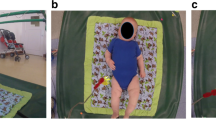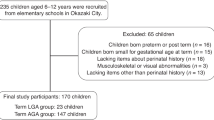Abstract
OBJECTIVE: Determination of bone strength of lower extremities in very low birth weight (VLBW) premature infants with central nervous system pathology resulting in reduced unilateral spontaneous leg movements.
STUDY DESIGN: Quantitative ultrasound (QUS) measurements of speed of sound (SOS) of the tibiae of both legs in three VLBW premature infants with brain insult and unilateral reduced spontaneous activity. Results were compared to QUS measurements of both legs in healthy premature infants. Measurements were performed by the same investigator who was blinded to the clinical course of the participants.
RESULTS: Reduced spontaneous activity of one leg due to brain pathology resulted in decreased tibial SOS in the affected side. There was no difference in bone SOS between the legs of the healthy controls.
CONCLUSION: Spontaneous movements (mainly antigravity flexion and extension) are important for bone structure and mineralization in VLBW premature infants. QUS may become an important diagnostic modality for the evaluation, treatment, and follow-up of bone strength and osteopenia in this unique population.
This is a preview of subscription content, access via your institution
Access options
Subscribe to this journal
Receive 12 print issues and online access
$259.00 per year
only $21.58 per issue
Buy this article
- Purchase on Springer Link
- Instant access to full article PDF
Prices may be subject to local taxes which are calculated during checkout
Similar content being viewed by others
References
Eliakim A, Raisz LG, Brasel JA, Cooper DM . Evidence for increased bone formation following a brief endurance-type training intervention in adolescent males J Bone Miner Res 1997 12: 1708–12
Myburgh KH . Exercise and peak bone mass: an update S Afr J Sports Med 1998 5: 3–9
Slemenda CW, Miller JZ, Hui SL, Reister TK, Johnston CC . Role of physical activity in the development of skeletal mass in children J Bone Miner Res 1991 6: 1227–33
Mazess RB, Whedon GD . Immobilization and bone Calcif Tissue Res 1983 35: 265–7
Demarini D, Mimouni FB, Tsang RC . Rickets of prematurity In: Fanaroff AA, Martin RJ, editors Neonatal–Perinatal Medicine — Diseases of the Fetus and Infant St. Louis: Mosby 1997 p 1473–6
Prins SH, Jorgensen HL, Jorgensen LV, Hassager C . The role of quantitative ultrasound in the assessment of bone: a review Clin Physiol 1998 18: 3–17
Foldes AJ, Rimon A, Keinan DD, Popovetzer MM . Quantitative ultrasound of the tibia: a novel approach for assessment of bone status Bone 1995 17: 363–7
Kang C, Speller R . Comparison of ultrasound and dual energy X-ray absorptiometry measurements in the calcaneus Br J Radiol 1998 71: 861–7
Njeh CF, Hans D, Wu C et al. An in vitro investigation of the dependence on sample thickness of the speed of sound along the specimen Med Eng Phys 1999 21: 651–9
Pearce S, Hurtig MB, Runciman J, Dickey J . Effect of age, anatomic site and soft tissue on quantitative ultrasound J Bone Miner Res 2000 15: S407
Sievonen H, Cheng S, Olikainen S, Uusi-Rasi K . Ultrasound velocity and cortical bone characteristics in-vivo Osteoporos Int 2001 5: 399–405
Wright LL, Glade MJ, Gopal J . The use of transmission ultrasonics to assess bone status in the human newborn Pediatr Res 1987 22: 541–4
Nemet D, Dolfin T, Wolach B, Eliakim A . Quantitative ultrasound measurements of bone speed of sound in premature infants Eur J Pediatr 2001 160: 736–40
Moyer-Mileur L, Leutkermeler M, Boomer L, Chan GM . Effect of physical activity on bone mineralization in premature infants J Pediatr 1995 127: 620–5
Nemet D, Dolfin T, Litmanowitz I, Shainkin-Kestenbaum R, Lis M, Eliakim A . Evidence for exercise-induced bone formation in premature infants Int J Sports Med 2002 23: 82–5
Abendschein W, Hyatt GW . Ultrasonic and selected physical properties of bone Clin Orthop 1970 69: 294–301
Greenfield MA, Craven JD, Huddelston A, Kehrer ML, Wishko D, Stern R . Measurements of the velocity of ultrasound in human cortical bone in vivo Radiology 1981 138: 701–10
Kleerekoper M, Villanueva AR, Stanciv J, Sudhaker Rao D, Parfitt AM . The role of three dimensional trabecular microstructure in the pathogenesis of vertebral compression fractures Calcif Tissue Int 1985 37: 594–7
Author information
Authors and Affiliations
Rights and permissions
About this article
Cite this article
Eliakim, A., Nemet, D., Friedland, O. et al. Spontaneous Activity in Premature Infants Affects Bone Strength. J Perinatol 22, 650–652 (2002). https://doi.org/10.1038/sj.jp.7210820
Published:
Issue Date:
DOI: https://doi.org/10.1038/sj.jp.7210820
This article is cited by
-
Assisted Physical Exercise for Improving Bone Strength in Preterm Infants Less than 35 Weeks Gestation: A Randomized Controlled Trial
Indian Pediatrics (2018)
-
The Effect of Assisted Exercise Frequency on Bone Strength in Very Low Birth Weight Preterm Infants: A Randomized Control Trial
Calcified Tissue International (2016)
-
High Beta-Palmitate Formula and Bone Strength in Term Infants: A Randomized, Double-Blind, Controlled Trial
Calcified Tissue International (2013)
-
Longitudinal Changes of Bone Ultrasound Measurements in Healthy Infants during the First Year of Life: Influence of Gender and Type of Feeding
Calcified Tissue International (2011)
-
Effects of a Prolonged Submersion on Bone Strength and Metabolism in Young Healthy Submariners
Calcified Tissue International (2010)



